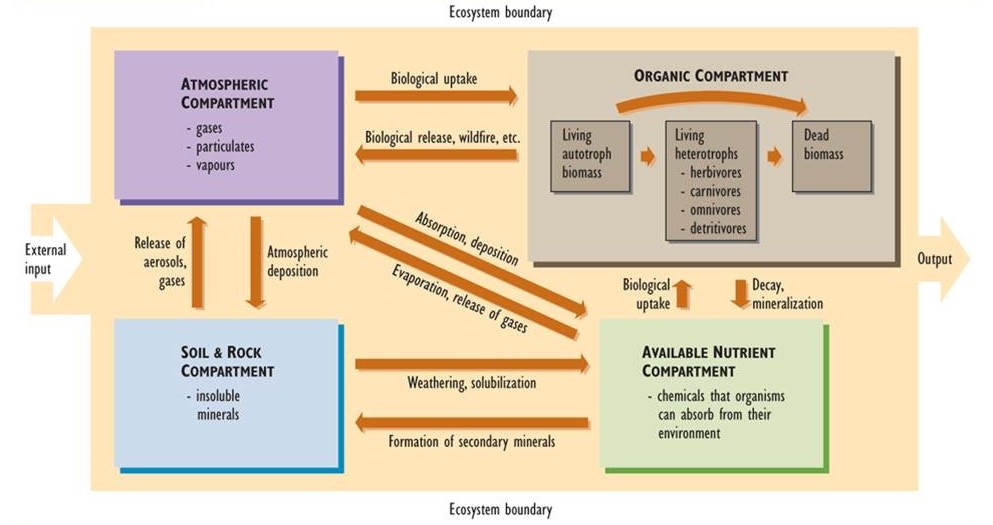Describe How Nutrients Are Passed Between Organisms and the Environment
How much of the mices energy is passed to the wolves. Provide building blocks and energy that organisms need.
Nutrient Cycling Crandall Park Trees
Food chains start with producers.

. Matter movement through an ecosystem Unlike the one way flow of energy matter is recycled within between ecosystems Nutrients are passed between organisms the environment through biogeochemical cycles Biogeochemical Cycles Bio life Geo Earth Chemi chemical 1. This consumer is then eaten by another animal which gains the nutrients from the first. Biologists describe nutrients as moving through cycles because the substances.
Every living organism needs nutrients to build tissues and carry out essential life functions. Consumer as an organism that gets its energy by feeding on other organisms. Energy is passed between organisms through the food chain.
Describe how nutrients are passed between organisms and the environment. The three pathways or cycles that move carbon nitrogen and phosphorus through the biosphere are especially critical for life. In ecosystems matter and energy are transferred from one form to another.
Plants are eaten by herbivores which gain nutrients from the plants that are used for growth. Some types of fungi and bacteria can break down fallen wood and litter returning nutrients to the soil. This energy is then passed on to the rest of the organisms in the environment by the food chain and food web.
Are passed between organisms and the environment and then back to organisms. Whilst mammals get their energy sources from food whether this be eating other animals or eating vegetation. This directly results in the type of organisms that can be found.
Start as simple organic forms that plants need. Decomposers break down dead plant and animal matter. Plants receive nutrients from the soil and then chemically combine them with carbon dioxide and water from the air to make food.
This relationship is an example of mutualism because the cows. Producer as an organism that makes its own organic nutrients usually using energy from sunlight through photosynthesis. Organisms which feed on plants or other animals are known as consumers.
The waste and dead matter are broken down by decomposers and the nutrients are recycled into the soil to be taken up again by plants but most of the energy is changed to heat during this process. Primary producers primary consumers and higher-level consumers are used to describe ecosystem structure and dynamics. Like water nutrients pass through organisms and the environment through biogeochemical cycles.
Within the food chain energy can be passed and transferred from one organism to another. A community of organisms and the environment in which they live in. Food chains start with producers.
On average only about 10 percent of energy stored as biomass in a trophic level is passed from one level to the next. A Population B Habitat C Community D. This food is passed onto animals as required nutrients and along the food chain as animals eat each other.
Decomposers release inorganic nutrients back in the environment by decomposing the organic compounds. Energy is passed between organisms through the food chain. These nutrients can be incorporated into the stream food web through direct consumption of carcass tissue by fish or invertebrates or uptake of the dissolved chemicals released during decomposition of carcasses Bilby et al.
Similar to water nutrients are passed between organisms and the environment through biogeochemical cycles. Ecosystem structure and patterns 8. Nutrient cycling is a cyclic manner to move back and forth between living organisms.
Matter refers to all of the living and nonliving things in that environment. Describe the importance of protists in the ocean The protists and their products from SCIENCE 2234 at Waller High School- Waller TX. Are needed by organisms to carry out life processes.
There is a single path through the chain. Plants get their energy from photosynthesis. Nutrients and living matter are passed from producers to consumers then broken down by decomposers.
Matter is recycled within and between ecosystems. Depending on their role as producers or. The biotic and abiotic factors of the ecosystem may vary with location and time.
Soil The type of soil available in an area determines the type of vegetation. Plants capture this energy and manufacture food by the process of photosynthesis. Each organism in a food chain occupies what is called a trophic level.
In ecology a food chain is a linear sequence of organisms through which nutrients and energy pass. Each of these organisms has its own trophic level. A 50 percent B 75 percent C 1 percent D.
Food web as a network of interconnected food chains. Micro-consumers are usually the decomposers that include saprophytic fungi bacteria and Actinomycetes. Herbivore as an animal that gets its energy by eating plants.
The bacteria receive nutrients from food the cows eat.

Food Web Concept And Applications Learn Science At Scitable

Chapter 5 Flows And Cycles Of Nutrients Environmental Science

Simple Ecosystem Diagram Ecosystems Desert Ecosystem Biology Projects
0 Response to "Describe How Nutrients Are Passed Between Organisms and the Environment"
Post a Comment